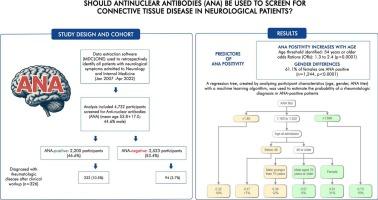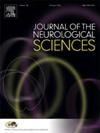抗核抗体(ANA)应该用于神经系统结缔组织疾病的筛查吗?
IF 3.2
3区 医学
Q1 CLINICAL NEUROLOGY
引用次数: 0
摘要
背景:结缔组织疾病(CTD)患者可以有广泛的神经系统表现。神经系统症状可能是CTD的主要症状。因此,使用抗核抗体(ANA)筛查CTD是常见的做法。然而,由于在健康人群中有大量的ANA阳性,对结果的解释可能很复杂。方法:回顾性分析2007-2022年谢巴医疗中心因神经症状评估而住院的患者档案。收集有关流行病学、ANA状态和风湿病诊断的数据。结果:共审查4723例患者档案。其中46.6%为ANA阳性。其中6.9%被诊断为CTD。结论:女性、老年患者、ANA滴度高的患者以及诊断为非血管原因导致神经系统疾病的患者更有可能患有CTD,可能需要进一步评估。本文章由计算机程序翻译,如有差异,请以英文原文为准。

Should antinuclear antibodies (ANA) be used to screen for connective tissue disease in neurological patients?
Background
Patients with connective tissue diseases (CTD) can have a wide range of neurological manifestations. Neurological complaints may be the presenting symptom of CTD. Therefore, screening for CTD using anti-nuclear antibodies (ANA) is a common practice. However, due to the abundance of positive ANA in a healthy population, interpretation of the results may be complex.
Methods
we retrospectively evaluated files of patients hospitalized for evaluation of neurological symptoms in Sheba Medical Center during the years 2007–2022. Data was collected regarding epidemiology, ANA status, and rheumatological diagnosis.
Results
4723 patients' files were reviewed. Of them, 46.6 % were positive for ANA. 6.9 % of them were diagnosed with CTD. This population had significantly higher rates of positive ANA status (71.2 % vs 28.8 %, p < 0.001), was significantly older (59.4 vs 53.4 years, p < 0.001) and had a significantly higher ANA titer (1:484.8, 1:268 p < 0.001) compared to patients without CTD. Factors which were found predictive for CTD diagnosis included female gender, older age, ANA titer above 1:160, and the diagnosis of a non-vascular etiology for the neurological disease.
Conclusion
Females, older patients, patients with high ANA titer and with diagnosis of a non-vascular cause to their neurological complains may be more likely to harbor a CTD and should probably be further evaluated.
求助全文
通过发布文献求助,成功后即可免费获取论文全文。
去求助
来源期刊

Journal of the Neurological Sciences
医学-临床神经学
CiteScore
7.60
自引率
2.30%
发文量
313
审稿时长
22 days
期刊介绍:
The Journal of the Neurological Sciences provides a medium for the prompt publication of original articles in neurology and neuroscience from around the world. JNS places special emphasis on articles that: 1) provide guidance to clinicians around the world (Best Practices, Global Neurology); 2) report cutting-edge science related to neurology (Basic and Translational Sciences); 3) educate readers about relevant and practical clinical outcomes in neurology (Outcomes Research); and 4) summarize or editorialize the current state of the literature (Reviews, Commentaries, and Editorials).
JNS accepts most types of manuscripts for consideration including original research papers, short communications, reviews, book reviews, letters to the Editor, opinions and editorials. Topics considered will be from neurology-related fields that are of interest to practicing physicians around the world. Examples include neuromuscular diseases, demyelination, atrophies, dementia, neoplasms, infections, epilepsies, disturbances of consciousness, stroke and cerebral circulation, growth and development, plasticity and intermediary metabolism.
 求助内容:
求助内容: 应助结果提醒方式:
应助结果提醒方式:


